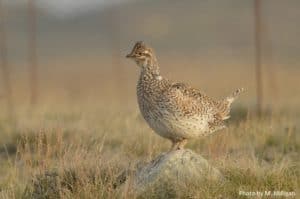Share this article
JWM: Grazing aids grouse — but not how researchers expected
Specially tailored grazing on the Montana prairie doesn’t benefit sharp-tailed grouse, researchers found, but keeping cattle on the landscape — rather than converting it to farmland — may be critical.
“Their survival is mostly affected by cultivation — crop agriculture,” said Megan Milligan, a postdoctoral research at the U.S. Geological Survey and the lead author of a study published recently in the Journal of Wildlife Management.
Wildlife managers had previously used cattle grazing management to improve sharp‐tailed grouse (Tympanuchus phasianellus) habitats in the state’s grasslands. This strategy was partly based on research from other parts of the country that showed burning and grazing on patches of tallgrass prairie has positive effects on vegetation as it mimics a more historic burn regime.
In Montana, managers assumed that allowing cattle to graze in patches then resting the land might have similar effects in the drier, mixed prairies of Montana and the Dakotas. The “rest-rotation grazing” technique involves moving cattle around the landscape, allowing grazing in selective areas before allowing the vegetation to recover.

A male sharp-tailed grouse.
Credit: Megan Milligan
Milligan and her co-authors wanted to see if this strategy was positively affecting grouse populations. They placed radio-collars on about 150 birds and monitored them from 2016 to 2018, observing reproduction, habitat use and survival during the breeding season from March to August and less frequently throughout the rest of the year.
When they looked at the data, the researchers were surprised. They found that vegetation was similar in all areas they monitored, whether what they call “rest-rotation” grazing was used in them or not. While other parts of the country found grazing management could aid grouse species, Milligan said, her team found no benefit to sharp-tailed grouse.
But while grazing management doesn’t seem to affect the birds, crop agriculture does.
“If you can try and keep these ranching systems intact and keep it from being converted to crop agriculture, that’s the best conservation strategy for these animals,” she said. “[Our study] suggests that you don’t need a very specialized system.”
This article features research that was published in a TWS peer-reviewed journal. Individual online access to all TWS journal articles is a benefit of membership. Join TWS now to read the latest in wildlife research.
Header Image: A male sharp-tailed grouse male appears in a mating dance pose. Credit: Megan Milligan








